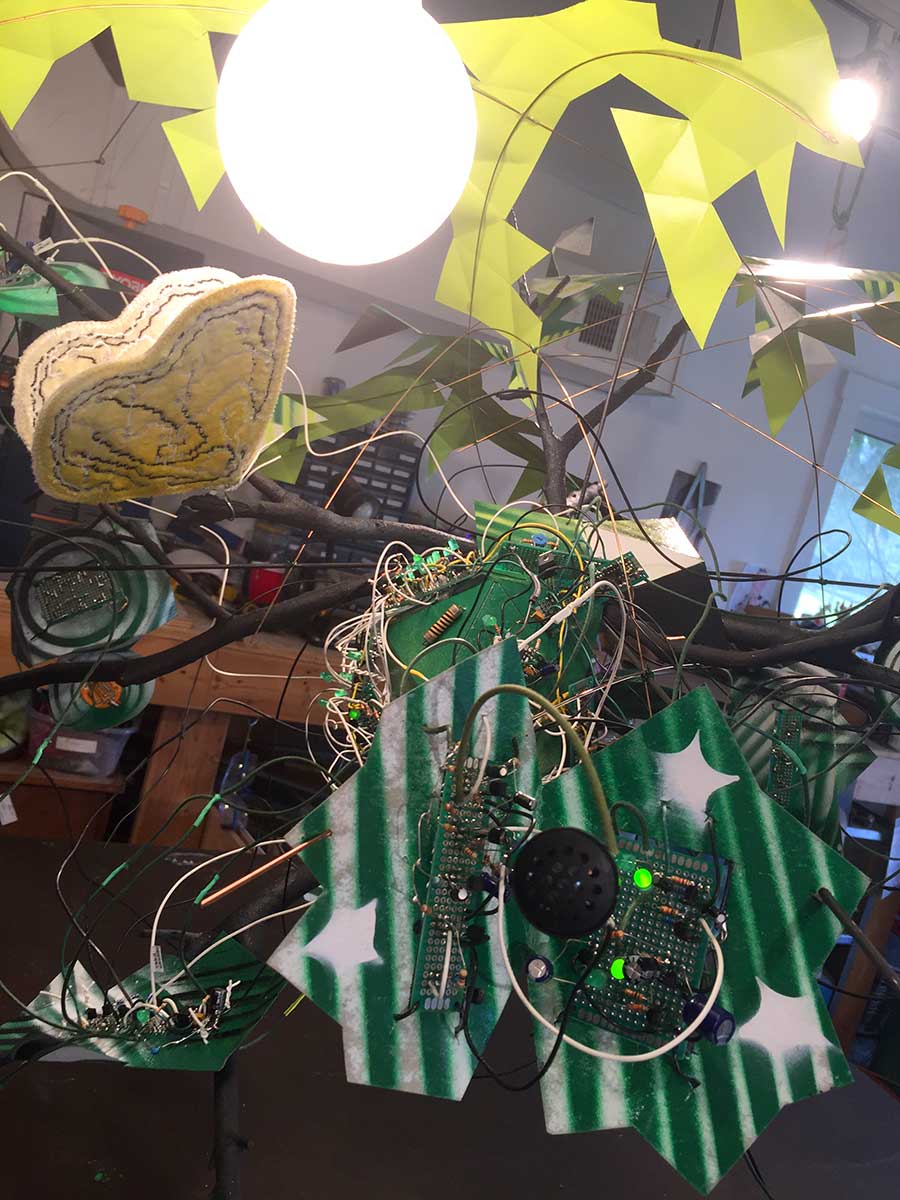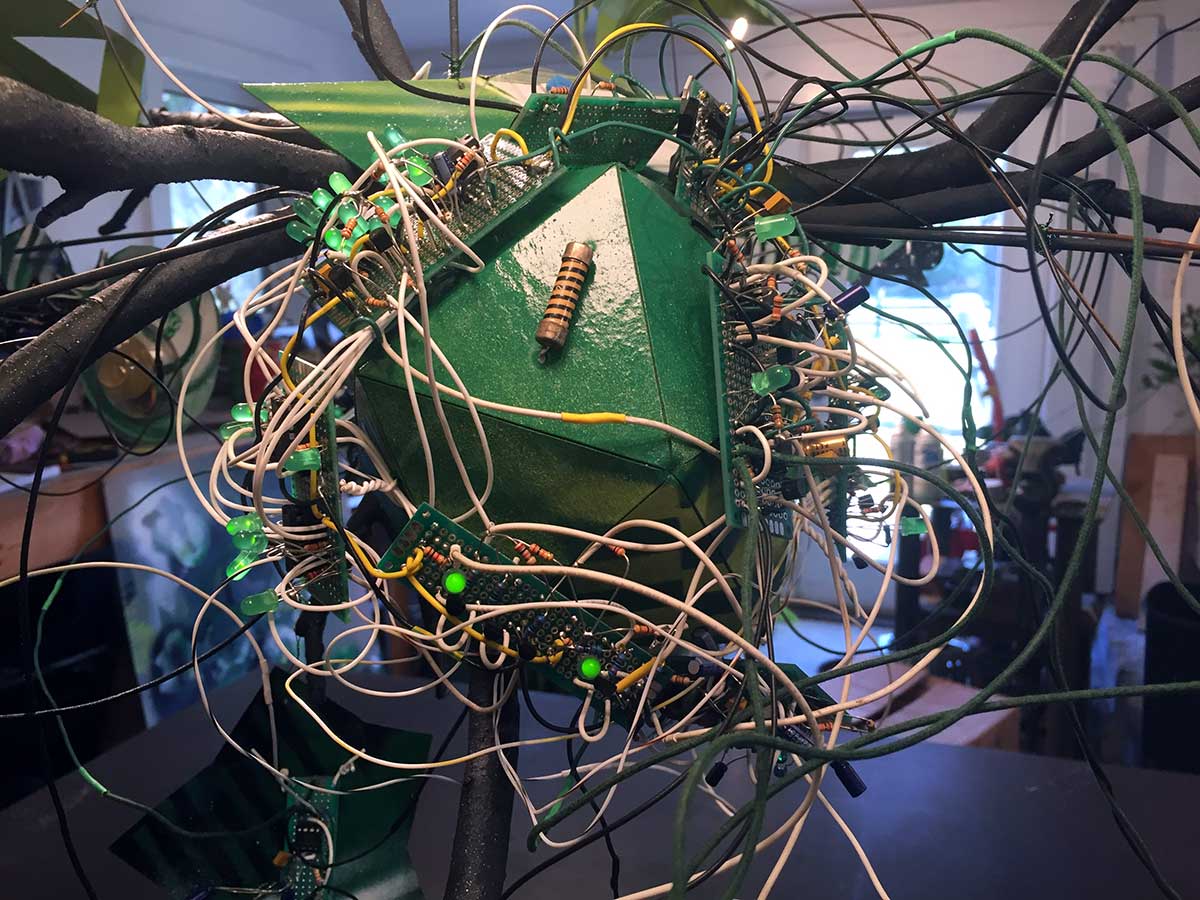Two Cricket Tableaux (artist proofs 1 of 3), 2020. Archival inkjet print, printed circuit boards, and analog electronics on panel with artist-made frame. 8” x 10” x 2”
cricket
Electrolier (September night in Virginia) /
I've been working around the clock to finish my Hackaday Prize application and pack for Hacking Nature's Musicians in Mexico. As closure for my recent chapter, the various circuits that I've shown you over the past few weeks have migrated from my bench and into a sculpture titled "Electrolier (September night in Virginia)," 2018. Here is an informal video:
The video quality isn't great... (shot with my iPhone under bad lighting and extremely messy studio)... but hopefully you get the idea. The sculpture contains one instance of my Mother Nature board design, recognizable by the dense tangle of white wires connecting logic gates, and six sound generating "animal circuits" each with its own speaker. The colorful graphics are spray painted cardboard, and everything is hung on a tree structure under a moon (globe pendant bulb). Oh, and that large moth is made out of silk velvet that I dyed and embroidered with an old industrial "Ultramatic" machine. I would have used small molex-style connectors to connect everything, but there was no time.
It's interesting that so many long wires didn't screw up my signals. I credit this to my use of common emitter amplifiers to buffer the signals, and the fact that I'm not drawing much current for anything you see (or hear). The whole sculpture is powered with a 12VDC / 1.5 amp power supply. I also used multiple 0.1 uF ceramic capacitors between power and ground on most of the individual perfboards. It's critical to remember power-ground capacitors when you're dealing with a lot of amplified signals banging on your power rails. I'm careful to avoid really small gauge wire, and I add many pathways to ground ("let ground abound.")
So... now I am packing my electronics bench into a suitcase and praying that security does not detain me at the airport. I'm throwing in packets of desiccant and crossing my fingers that jungle humidity doesn't zap everything. Making analog electronic circuits in the jungle will be interesting to say the least -- stay tuned for the sounds of los músicos de la naturaleza en Quintana Roo!
Mother Nature Board /
If you’re curious about how I create circuits for my electronic art, check out my new project “Hacking Nature’s Musicians” on Hackaday.io. In a recent entry, I explain how I built a random pulse generator to simulate the natural “timing effects” of Mother Nature conducting a chorus.
Below (and on Vimeo) is a video overview of the circuit.
Follow me on Hackaday /
I have started a project to describe and share my analog electronic circuits designs so that people can better understand my electronic practice. My project, located on Hackaday.io, is called “Hacking Nature’s Musicians.” You can find it here: https://hackaday.io/project/161443-hacking-natures-musicians
In a recent project log, I describe how I create chirping crickets using discrete transistors. Check it out: https://hackaday.io/project/161443-hacking-natures-musicians/log/153312-crickets-natures-favorite-astable-multivibrator
Prototyping Night Insects /
Here I am at my bench prototyping various analog electronic insects for my latest "electrolier" sculpture. The sounds are made using a combination of astable multivibrators (oscillators), some of which create the audio timber and others establish a chirp-like tempo. The speakers are custom piezo electric devices that I have physically modified to achieve different sound qualities, such as brighter versus muffled and close versus distant. Individuality is achieved by subtle variations in the electrical signal and the output device.
Designing creatures of the night /
Cricket PCB /
My first cricket circuit board arrived today and it chirps!
Astable multivibrator circuit built with discrete transistors. The circuit generates a waveform that sounds like a cricket when applied to a piezo electric buzzer. Kelly Heaton, 2018
I did make one error in my schematic, which involved the reversal of the PNP transistor (3906). Thankfully, the wiring worked perfectly when I turned the PNP in the opposite direction.
Cricket Circuit /
The chirping piezo electric circuit from my last post is getting a body. I did the layout in KiCad and sent my boards for manufacture by PCBWay (based on a colleague's recommendation). Their interface is not as user-friendly as OSH Park, but they offer a variety of solder mask colors - not just purple. I ordered this guy in black. I'll post an update when the boards are wired up and chirping.
Board layout in KiCad
KiCad 3d simulation of the pcb











